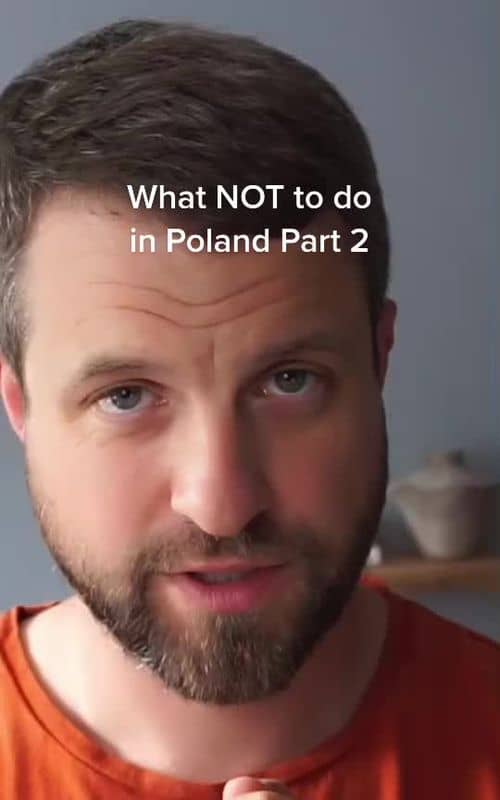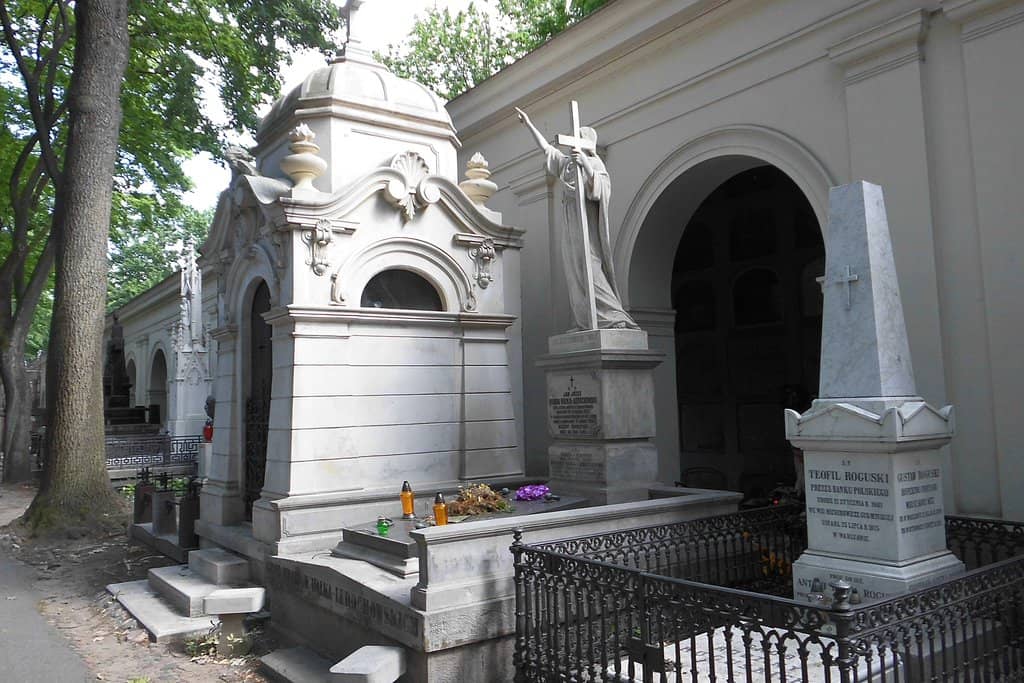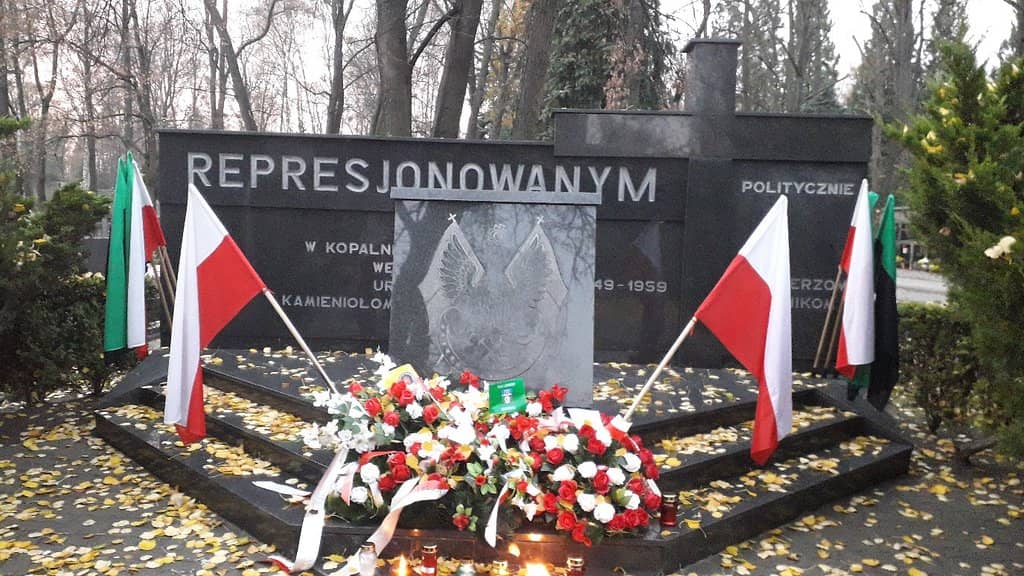
Powązki Military Cemetery Warsaw
A solemn and expansive military cemetery in Warsaw, honoring Polish heroes and bearing witness to the nation's turbulent history.

Highlights
Must-see attractions

Social
From TikTok & Reddit
Best Time
Pleasant weather, fewer crowds

Powązki Military Cemetery Warsaw
Best Time
Pleasant weather, fewer crowds

Highlights
Must-see attractions
A solemn and expansive military cemetery in Warsaw, honoring Polish heroes and bearing witness to the nation's turbulent history.
"A place of great history of Poland where many heroes rest in there."

Wear Comfortable Shoes
You'll be doing a lot of walking across a large area. :athletic_shoe:
Allow Ample Time
This is a vast cemetery; dedicate at least 2-3 hours to explore properly. :clock1:

Highlights
Discover the most iconic attractions and experiences

Władysław Szpilman's Grave
Section B-II-12
Visit the final resting place of the pianist whose survival story inspired 'The Pianist'.

Smolensk Tragedy Monument
Central part of the cemetery
A poignant monument commemorating the 2010 plane crash that claimed the lives of many Polish dignitaries.

Heroes of Uprisings and Wars
Various sections
Explore the graves of soldiers and heroes from WWI, WWII, and the Warsaw Uprising.
Plans like a pro.
Thinks like you
Planning Your Visit
Respectful Visitation
Photography Considerations
Best Times
Insider Tips
from TikTok, Instagram & Reddit
Wear Comfortable Shoes
You'll be doing a lot of walking across a large area. :athletic_shoe:
Allow Ample Time
This is a vast cemetery; dedicate at least 2-3 hours to explore properly. :clock1:
Cemetery in Warsaw on All Souls' Day.
Check for Events
Special ceremonies or commemorations might be taking place. :calendar:
Bring Water
Especially during warmer months, stay hydrated. :droplet:
Powązki Military Cemetery in Warsaw (Cmentarz Wojskowy) 🕯🇵🇱
Tips
from all over the internet
Wear Comfortable Shoes
You'll be doing a lot of walking across a large area. :athletic_shoe:
Allow Ample Time
This is a vast cemetery; dedicate at least 2-3 hours to explore properly. :clock1:
Check for Events
Special ceremonies or commemorations might be taking place. :calendar:
Bring Water
Especially during warmer months, stay hydrated. :droplet:
What Travellers Say
Reviews Summary
Visitors find Powązki Military Cemetery to be a deeply moving and historically significant site, offering a profound glimpse into Poland's past and the sacrifices of its heroes. While some note the presence of controversial graves, the overwhelming sentiment is one of respect and awe for the courage and resilience of the Polish people. It's considered a unique and essential stop for understanding Warsaw's history.
"This military cemetery was established before World War I and has war graves from WWI, WWII, the Warsaw Uprising and many famous people. One of the famous graves is Wladyslaw Szpilman, who wrote an autobiography titled Death of a City.... about his survival in Warsaw during World War II....the 2002 film The Pianist."
The WWII Professor
"More than cemetery. This a place where history is mixed with heroes and ordinary people and soldiers who died during the last hundred years or so. You will find many famous people buried there as well as great old trees. A place full of mysterious climate."
Oakfriend
"Probably the most unusual first place to visit as a tourist, but i liked it. There were some graves that caught my attention and made me look up who they were. But the main reason why i had to visit was the Smolensk Tragedy monument."
Edvinas Klėjus
What People Like
What People Dislike
Frequently Asked Questions
🚇 🗺️ Getting There
The cemetery is accessible by public transport. Several bus lines stop nearby, including routes that connect to the city center. Trams also serve the area. Consider using a navigation app for real-time routes.
Limited parking may be available, but it's often best to rely on public transportation due to the cemetery's popularity and size. Check local signage for designated parking areas.
It's a significant distance to walk from the absolute center of Warsaw. Public transport is highly recommended for efficiency and comfort.
The cemetery is extensive. Grab a map at the entrance if available, or use your phone's GPS. Many visitors find it helpful to focus on specific sections or notable graves.
While not always advertised, sometimes local guides offer tours. Inquire at the entrance or look for information online.
🎫 🎫 Tickets & Entry
Entry to Powązki Military Cemetery is generally free. It's a public space for remembrance and reflection.
The cemetery typically has extended opening hours, often from early morning until dusk. It's advisable to check the official website or local listings for the most current times, especially around holidays.
While general entry is free, special commemorative events might have associated costs or require prior registration.
Yes, All Souls' Day (November 1st) is a significant time for visiting cemeteries in Poland. Expect larger crowds and many candles lit.
Visitors are expected to behave respectfully. Large groups should be mindful of ongoing ceremonies.
📸 📸 Photography
Photography is generally permitted for personal use, but always be respectful. Avoid intrusive shots of mourners or ceremonies.
Drones are typically prohibited in cemeteries to ensure peace and respect. Always check local regulations before flying.
The grand monuments, older sections with mature trees, and the graves of famous figures offer compelling photographic opportunities. The atmosphere can be particularly striking on overcast days.
During official ceremonies or religious services, photography may be restricted or require special permission.
A camera with good low-light performance is beneficial, especially for capturing the atmospheric feel. A wide-angle lens can help capture the scale of the monuments.
🎫 🏛️ History & Significance
Established in 1912, it's a burial ground for Polish soldiers and heroes from various conflicts, including WWI, WWII, and the Warsaw Uprising. It's a testament to Poland's struggle for independence.
Notable figures include Władysław Szpilman (pianist), numerous military leaders, artists, and politicians.
It's a memorial dedicated to the victims of the 2010 plane crash that tragically killed Polish President Lech Kaczyński and many other prominent figures.
The combination of historical depth, grand old trees, and the solemn nature of a burial ground creates a unique, often somber and reflective atmosphere.
Yes, due to its history, the cemetery contains graves of individuals from different political eras, which can be a point of contention for some visitors.
For Different Travelers
Tailored advice for your travel style
👨👩👧 Families with Kids
📸 Photography Enthusiasts
🏛️ History Buffs
Deep Dives
In-depth insights and expert knowledge
A Living Chronicle of Polish History
Among the most poignant sites is the grave of Władysław Szpilman, the renowned pianist whose survival during the Nazi occupation of Warsaw was immortalized in the film 'The Pianist'. His story is a powerful reminder of individual resilience amidst immense suffering. Another significant landmark is the Smolensk Tragedy Monument, a solemn tribute to the 96 people, including President Lech Kaczyński, who perished in the 2010 plane crash. These specific memorials, alongside countless unnamed graves, contribute to the cemetery's deeply moving and often overwhelming atmosphere, making it a crucial site for understanding Poland's 20th-century history.
Navigating this expansive site can be an emotional journey. The sheer scale of the cemetery, combined with the weight of history, can be profoundly impactful. Many visitors report feeling a deep connection to the past and a renewed appreciation for the sacrifices made. It's a place that encourages reflection on courage, loss, and the enduring spirit of a nation.
Photography and Atmosphere
When photographing, focus on the details that tell a story: the inscriptions on the tombstones, the artistry of the monuments, and the interplay of light and shadow among the trees. The Smolensk Tragedy Monument and the graves of notable figures like Władysław Szpilman are popular subjects, but don't overlook the quiet beauty of older, less ornate graves. Remember that this is a place of remembrance, so always be discreet and respectful. Avoid intrusive flash photography, especially near ceremonies or mourners.
While drones are generally prohibited, a good quality camera with decent low-light capabilities will serve you well. Consider a wide-angle lens to capture the grandeur of the larger monuments and the vastness of the cemetery, and a prime lens for detailed shots of inscriptions or sculptural elements. The goal is to capture the cemetery's profound sense of history and its quiet, contemplative spirit.






Social
from TikTok, Instagram & Reddit